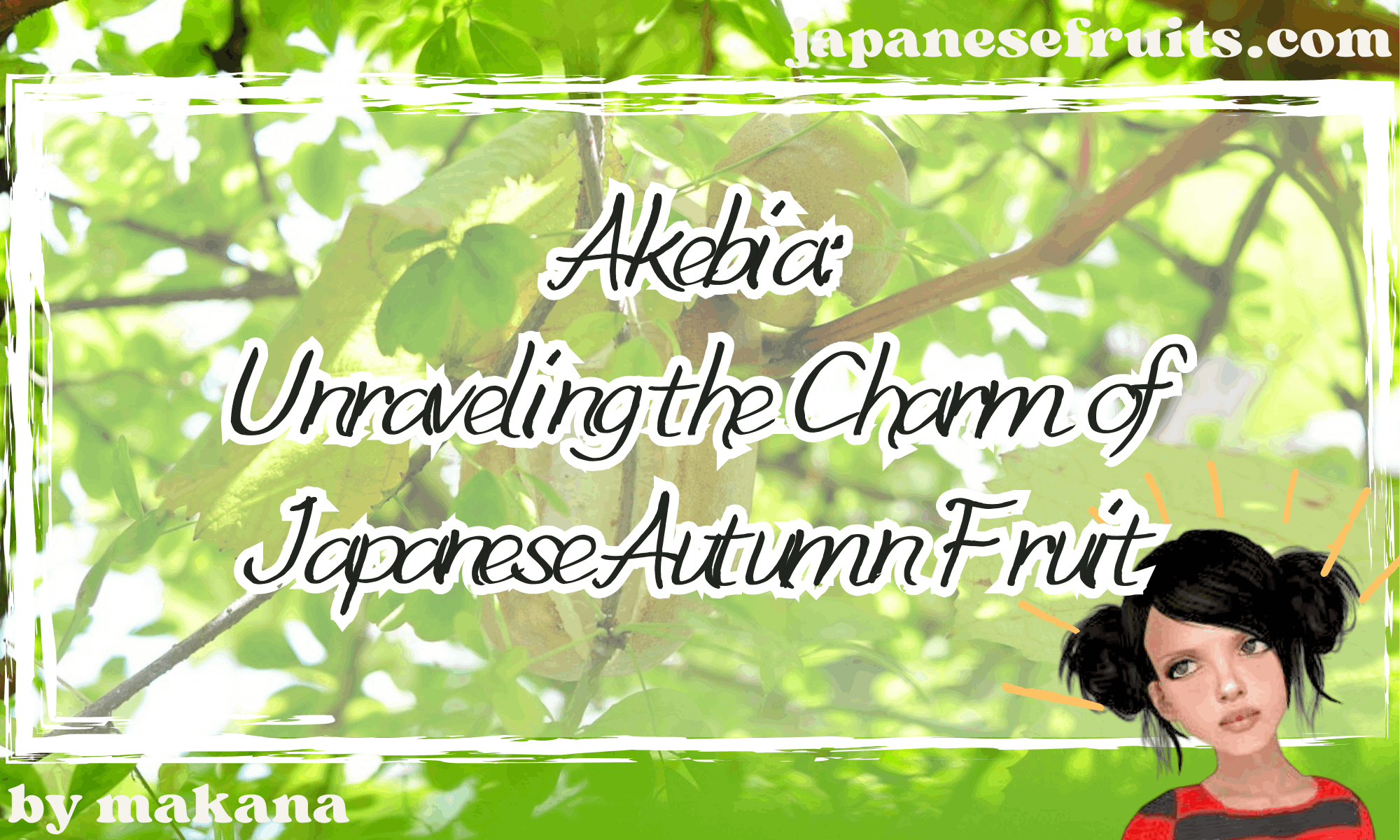Hello everyone! I’m Makana.As a fruit blogger dedicated to sharing the allure of Japanese fruits with the world, I have a personal connection to natural foods. Having overcome childhood frailty through discovering natural foods, I now work to convey the wonders of traditional ingredients. Exploring Japan’s fruits with my cooking-enthusiast husband brings me immense joy.Today, I’d like to introduce you to the “akebia,” a fruit deeply rooted in Japanese life yet still relatively unknown overseas.Growing up in Chiba Prefecture, akebia was a quintessential autumn sight for me. While the region is famous for pears, watermelons, and loquats, akebia holds a special charm for Japanese people, popular both as a garden plant and as a fruit.Indeed, akebia is more than just food. Its fruit adorns our tables, its sturdy vines serve as material for crafts, and the entire plant is cherished as a vital part of Japanese culture and history.Interestingly, akebia is now found worldwide, though this isn’t entirely positive. Let’s delve into the appeal of this traditional Japanese fruit and its global significance.
What is Akebia?
Akebia (scientific name: Akebia quinata) is a deciduous vine native to Japan. It produces delicate purple flowers in spring and deep purple fruits in autumn.The name has an interesting origin. The most accepted theory is that it comes from “akemi” (開け実), meaning “opening fruit,” due to how the ripe fruit naturally splits open. Another theory suggests it’s named after how the splitting fruit resembles a human yawn. In kanji, it’s written as 通草 (tsuusou), referring to how one can blow air through its hollow stem.While I live near strawberry greenhouses and just 30 minutes from a famous watermelon-producing area, akebia’s charm differs from cultivated fruits. It possesses a mystical allure as a gift of nature.
Akebia Varieties
Did you know there are mainly four varieties of akebia?
- Common Akebia: Deep purple fruit with five leaflets, producing delicate flowers in spring.
- Mitsuba Akebia: Yellow-ochre fruit with three leaflets, known for its cold resistance.
- Goyou Akebia: A hybrid of common and mitsuba akebia, sweeter and more valuable as a fruit.
- Mube (Tokiwa Akebia): Unique in that its fruit doesn’t split when ripe.
Akebia fruit consists of translucent white pulp and black seeds. The pulp is edible with a subtle, refined sweetness. As a child, I remember the fun of eating it by putting the whole fruit in my mouth and spitting out the seeds later.
Akebia in Japanese Crafts
Akebia’s appeal extends beyond its fruit. Its vines have played a crucial role in crafting, dating back to the Edo period.In the late Edo period, wild akebia vines were considered a nuisance, hindering crop growth. However, this changed when a visiting monk began crafting small items from the vines.In 1845, Yasunobu Kono invented the “nigiri-kanna,” a tool that allowed for uniform vine thickness, enabling more intricate crafts. Toshichi Kono further improved these tools, leading to even more beautiful products.A notable example is the “hato-guruma” (dove cart), a traditional craft from Nagano Prefecture. Made from woven akebia vines, it has captivated many hearts. Craftsman Heisaku Kono pursued a more realistic dove shape, creating a masterpiece that was ranked as a top toy nationally in 1963.Vine crafting once provided winter income for households, producing toys, baskets, geta soles, woven hats, trivets, and confectionery bowls. By 1875, these crafts were exhibited at the National Industrial Exhibition, solidifying their status as traditional Japanese crafts.
Akebia and Japanese Seasons
Akebia is deeply connected to Japanese seasons. In my area, akebia sprouts appear alongside loquat trees in spring.Interestingly, young akebia shoots are enjoyed as spring mountain vegetables, especially in Tohoku and Shin’etsu regions, where they’re called “kinome” and often served as ohitashi.In summer, the leaves grow lush, and by autumn, the purple fruits ripen. A particularly poignant tradition exists in Yamagata Prefecture: it’s believed that ancestral spirits return during the autumn equinox on akebia “boats,” leading people to offer akebia on their Buddhist altars.
Modern Appreciation of Akebia
Recently, high-end restaurants and ryokans have found new ways to enjoy akebia. The beautiful purple fruit is used as a serving vessel, creating seasonal presentations that are especially impressive to foreign guests and popular on Instagram.In Yamagata Prefecture, both the pulp and skin are traditionally eaten. The skin is stuffed with meat, deep-fried as tempura, or stir-fried, with its slight bitterness appreciated as an adult flavor.However, a serious issue must be addressed. Since its introduction to the West as an ornamental plant in the late 19th century, akebia has caused unexpected problems.Its hardy nature and strong reproductive ability, honed in Japanese wilderness, have made it an ecological threat abroad. In North America, particularly in the east, it has naturalized and is designated as an invasive species threatening native plants. Similar issues are reported in Europe, especially in the UK and France, where managing garden-escaped akebia is a challenge.
Akebia: Bridging Tradition and Future
Today, akebia maintains its value in traditional Japanese food culture and crafts while finding new potential. For instance, it’s being utilized as a tourism resource, with many foreign tourists marveling at the delicate techniques of vine crafting and gaining a deeper understanding of Japanese crafts.
Conclusion
Akebia is a special fruit that has been a part of Japanese life for generations. Its delicious fruit, use in crafts, and role in preserving traditional culture make it truly fascinating.What’s particularly striking is how its value has changed over time. Once considered a nuisance, the vines became prized craft materials, and the wild fruit is now a seasonal delicacy. Research into akebia oil is also revealing new possibilities.I believe this multifaceted charm of akebia reflects the depth of Japanese food culture. I hope to continue sharing Japanese culture and traditions through seasonal fruits.If you come across akebia, please experience its beauty and taste. And as you do, I hope you’ll reflect on the rich Japanese culture and history it represents.

Leave a Reply